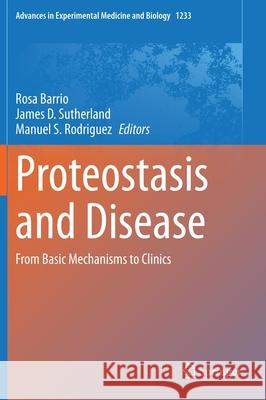Proteostasis and Disease: From Basic Mechanisms to Clinics » książka



Proteostasis and Disease: From Basic Mechanisms to Clinics
ISBN-13: 9783030382650 / Angielski / Twarda / 2020 / 348 str.
Proteostasis and Disease: From Basic Mechanisms to Clinics
ISBN-13: 9783030382650 / Angielski / Twarda / 2020 / 348 str.
(netto: 575,06 VAT: 5%)
Najniższa cena z 30 dni: 578,30
ok. 22 dni roboczych.
Darmowa dostawa!
PART I Cancer
1. Ubiquitin-regulated cell proliferation and cancer -Beatriz Pérez-Benavente, Alihamze Fathinajafabadi Nasresfahani and Rosa Farràs
2. Ubiquitin, SUMO and NEDD8 as therapeutic targets in cancer -Pierre Gâtel, Marc Piechaczyk and Guillaume Bossis
3.The proteasome system in health and disease - Olivier Coux, Barbara Zieba and Silke Meiners
4. Proteostasis dysregulation in pancreatic cancer- Leena Arpalahti, Caj Haglund, and Carina I. Holmberg
5. Divergent modulation of proteostasis in prostate cancer- Petek Ballar Kirmizibayrak, Burcu Erbaykent Tepedelen, Oguz Gozen, Yalcin Erzurumlu
6. Resistance to the proteasome inhibitors: lessons from multiple myeloma and mantle cell lymphoma - Maria Gonzalez-Santamarta, Grégoire Quinet, Diana Reyes-Garau, Brigitte Sola, Gaël Roué and Manuel S. Rodriguez
PART II Neurodegeneration
7. Altered proteostasis in neurodegenerative tauopathies - Katerina Papanikolopoulou and Efthimios MC Skoulakis8. The ubiquitin system in Alzheimer’s Disease - Lee D. Harris, Sarah Jasem & Julien D. F. Licchesi
9. The interplay between proteostasis systems and Parkinson's disease - Diana F. Lázaro and Tiago F. Outeiro
10. Machado-Jospeh Disease: A stress combating deubiquitylating enzyme changing sides - Nico P. Dantuma and Laura K. Herzog
PART III Infection, inflammation and developmental disorders
11. SUMO and cytoplasmic RNA viruses: from enemies to best friends - Ahmed El Motiam, Santiago Vidal, Rocío Seoane, Yanis H Bouzahe, José González-Santamaría, Carmen Rivas12. The role of proteostasis in the regulation of cardiac intercellular communication - Daniela Batista-Almeida, Tania Martins-Marques, Teresa Ribeiro-Rodrigues, Henrique Girao
13. By the tips of your cilia: ciliogenesis in the retina and the ubiquitin-proteasome system - Vasileios Toulis, Gemma Marfany
14. TRIM E3 ubiquitin ligases in rare genetic disorders - Germana Meroni
PART IV Diet
15. We are what we eat: Ubiquitin-proteasome System (UPS) modulation through dietary products -Eleni Panagiotidou and Niki Chondrogianni
Rosa Barrio obtained her PhD in the Centre of Molecular Biology Severo Ochoa (Madrid, Spain) on the study of ubiquitin genes in Drosophila. Since then, she was interested on the effect of ubiquitin-like molecules on relevant transcription factors involved in organismal development and physiology. After her postdoctoral training at European Molecular Biology Laboratory (Heidelberg, Germany), she is a principal investigator in the Functional Genomics Unit of CIC bioGUNE (Derio, Spain) since December 2004. Using Drosophila as a model system, her laboratory unveiled the role of SUMOylation in vivo in the processes of steroidogenesis through the regulation of the Steroidogenic Factor 1, and development through the regulation of the Spalt-like factors (SALL) and ciliogenesis. The laboratory developed technology for the study posttranslational modifications by members of the ubiquitin family, and apply this technology for the analysis of the ubiquitin code.
Jim Sutherland is a developmental/cellular biologist studying protein homeostasis regulation in the primary cilia. His doctoral research on USP/DHR38 heterodimers and the Drosophila ecdysone response was completed at Harvard University and EMBL under the supervision of Dr. Fotis Kafatos. His post-doctoral research was focused on the functional analysis of profilin and regulation of the actin cytoskeleton in the mouse (Witke Group, EMBL Rome) and on the role of TES in cellular adhesion (Way Group, Cancer Research UK, London). In 2005, he joined the Cooperative Research Centre bioGUNE (CIC bioGUNE) as a staff researcher. He develops novel tools for studying modifications by ubiquitin and ubiquitin-like proteins. These are applied towards understanding primary cilia formation and function, with special focus on Townes Brock Syndrome, a rare ciliopathy caused by SALL1 mutations and characterized by developmental defects and kidney dysfunction.
Manuel S Rodriguez obtained his PhD degree in microbiology at Pasteur Institute (Paris, France). Early in his carrier he became interested in the role of ubiquitin family members in the regulation of critical cellular factors such as those involved in the immune response, apoptosis or oncogenesis. He was particularly intrigued by the role of ubiquitin-like proteins (UbLs) in the regulation of protein homeostasis in situations when two or more members of this family were acting on the same protein or pathways. Some of his work was oriented to study the regulation of NF-kB and the tumour suppressor p53. More recently his efforts have been oriented to the study of the crosstalk between the ubiquitin proteasome and autophagy-Lysosome systems. His group became particularly interested in a selective autophagy mechanism named proteaphagy that appears to regulate the pool of 26S proteasome in response to proteasome inhibition. Among other contributions he developed methods to study post-modification events and its functional consequences. Including ubiquitin capturing systems (named TUBEs) based in the tandem disposition of ubiquitin binding domains and a version of SUMO-traps that have been used to study the response of the cell to distinct stimuli/infections. Manuel S. Rodriguez is currently a group leader at the Institute for advanced technologies in life sciences (ITAV) from the CNRS (Toulouse, France).This book, written by members of the European network PROTEOSTASIS, provides an up-to-date review of the research regarding protein homeostasis in health and disease. With new discoveries contributing to the increasing complexity of this topic, the book offers a detailed overview of the pathways regulating protein homeostasis, including autophagy and the ubiquitin protein family. Following a basic introduction, it explains how defects in protein homeostasis contribute to numerous pathologies, including cancer, neurodegeneration, inflammation and a number of rare diseases. In addition, it discusses, the role of protein homeostasis in cellular development and physiology.
Highlighting the latest research in the field of protein homeostasis and its implications for various clinically relevant diseases, the book appeals to researchers and clinicians, while also offering a reference guide for scholars who are new to the field.
1997-2026 DolnySlask.com Agencja Internetowa
KrainaKsiazek.PL - Księgarnia Internetowa









